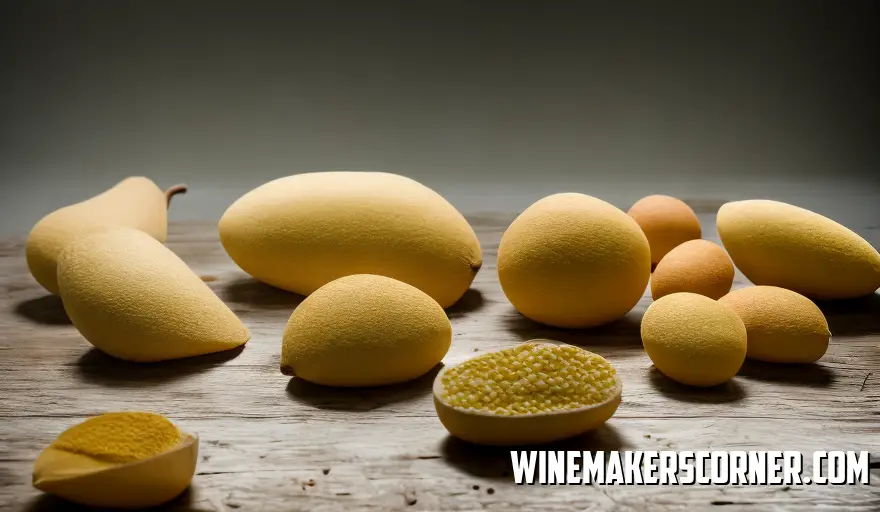There’s nothing quite like taking a sip from your crafted homemade wine; it’s rich texture and delectable flavor feel like music in your mouth. But what about those lurking doubts concerning health hazards? Is making wine at home a risky business? Let us put those worries aside – we’re here to shed light on any myths or truths tied to the safety of home Winemaking, so grab some popcorn because this will be one fun ride.
Table of Contents
The Science Behind Homemade Wine
Regarding DIY winemaking, opinions are divided between zealots who swear by it and skeptics who find it risky. For some people, crafting their libations results in a gratifying creative experience with one-of-a-kind rewards. Others are wary of consuming something whipped at home for fear of unforeseen health hazards. However, not everything’s black-and-white; let’s delve into the scientific background of homemade Winemaking for elucidation.
At its core lies fermentation – where yeast breaks down sugars into alcohol and CO2- which remains integral regardless if one produces commercial wines or domestic brews; Precision levels may differ though that can impact outcomes. To make a safe homemade hooch, one must emphasize Sanitation above all else- neglecting cleaning can result in harmful bacteria seeping through processes leading to ruined wine and dangerous health risks.
Lastly, the toxic compound methanol production comes into question. Commercial winemakers boast effective methods for its removal, while amateur enthusiasts might overlook it, leading to trace amounts of cutting.
Many people produce delightful and harmless wines in their homes by strictly following thorough cleaning measures, using premium ingredients, and regulating temperatures carefully throughout fermentation. As long as correct procedures are followed at home – there is no difference between the safety of commercially made or homemade wines. To conclude: while the potential exists to contract an illness from homemade wine if appropriate safety precautions aren’t taken during production taking care and adhering to recommended procedures is the key to safely enjoying your homemade wine.
Common Contaminants in Amateur Winemaking
As home winemaking becomes more trendy among enthusiasts looking for a new pastime activity, worries have arisen over whether or not homemade wines pose health risks worth worrying about.
Understanding common hazards encountered during amateur Winemaking could shed light on the safety of these practices.
Significantly bacteria present serious risks. While some bacteria are good for fermenting your wine – causing the yeast to transform sugar into alcohol others can cause undesirable odors or flavors in your batch. In worst-case scenarios consuming contaminated wine could result in food poisoning.
Another noteworthy point is wild yeast strains; although often harmless, introducing inappropriate songs can ruin your entire batch of homemade wine. Knowing how to identify these hazards and mitigate their effects is essential to enjoy a safe and delicious glass of homemade wine.
Lastly, mold contamination is a hazard worth keeping an eye out for during Winemaking if the equipment isn’t properly sanitized before use – leading eventually to the contamination of your precious batch of vino. Although molds usually don’t make people sick directly, they indicate unsanitary practices that could create problems – making it essential to sanitize gear regularly when making homemade wine.
Regarding homemade wine production, chemical contaminants must be considered before consumption. For example, Pesticide residue found on fruits during harvesting or using improper cleaning agents could contaminate the wine with hazardous chemicals causing significant health threats when ingested regularly over time. Furthermore, sulfites – commonly used for preservation by preventing oxidation and bacterial growth – require careful management to avoid complications like excessive headaches or allergic reactions caused by sensitivity.
In conclusion, while satisfying the desire for creativity and self-sufficiency, homemade wine also has its risks associated with contamination despite the amateur production methods, which can be mitigated by learning best practices related to sanitation and ingredient sourcing.
The Role of Sulfites in Wine Safety
The use of sulfites in wine safety has become a divided topic, from devoted wine enthusiasts to health-conscious individuals. Sulfur dioxide compounds utilized as preservatives prevent oxidation and preserve freshness during Winemaking. Still, concerns over their safety result from questions about whether consuming homemade wines without them poses any risks.
Not only do they preserve taste and color, but these additives also contain features that inhibit bacteria growth within commercial wineries- adhering too strictly regulated guidelines for consumer safety.
However, keeping things under control during home winemaking becomes increasingly complicated when we omit sulfite use- potentially leading to spoilage or pollution from unwanted microorganisms.
First, It must acknowledge that drinking contaminated homemade wine can cause sickness, yet solely contemplating the absence of sulfites is an inadequate explanation. Instead of attributing it solely towards lacking these additives, we must recognize they’re just one factor amongst many when dealing with variable-quality control issues present within homesteading and Winemaking. Safety is a top priority for most hobbyists who produce their wines at home by following strict hygiene protocols throughout every stage of fermentation while controlling environmental factors resulting in contaminations or spoilages risks reduction.
Nevertheless, sure folks suffer from adverse side effects after drinking store-bought selections containing preservatives like sulfur dioxide (sulfites). Allergic responses are typical symptoms such as migraines or allergic rashes; asthmatics can face respiratory problems from sulfite-filled wines.
Overall homemade and commercial wines have safety risks due to sulfite exposure making it necessary to consider personal health sensibilities.
Diligent home winemakers can achieve optimal fermentation conditions by following strict sanitation regulations that ensure safe-to-consume end products. Knowing what role sulfites play in wine preservation is vital regardless of the beverage chosen.
The Dangers of Methanol Poisoning
We should be mindful of the potential danger of methanol poisoning thainmemade wine. The likelihood may be low; however, its repercussions can be severe for those who indulge in DIY winemaking. Thus, this toxic substance poses an authentic threat that needs proper understanding and attention while pursuing one’s passion for Winemaking.
Methanol primarily appears due to improper fermentation, creating it as an accidental byproduct. Therefore, safeguarding oneself through careful monitoring and control during fermentation is crucial to prevent its incidence. While symptoms may take time to appear after consumption such as nausea, vomiting, or abdominal pain – they do grow progressively worse if left unchecked, leading to dizziness and visual impairments with large amounts consumed resulting, ultimately resulting in serious health problems or death., Survivors might have blindness as an added consequence of methanol poisoning. It’s necessary to prioritize prevention to combat this dangerous foe and keep oneself safe. Minimizing risks associated with homemade wine production means having the right equipment and following guidelines accurately.
While homemade vino might present an exciting adventure for those who want a fresh challenge or looking for ways to save money, one must proceed with care along this path of exploration. Raising awareness regarding methanol poisoning could go a long way towards preventing both passionate winemakers’ and consumers’ unnecessary suffering from harm while possibly saving lives.
Proper Sanitation and Storage Techniques
Creating homemade wine can be a delightful hobby for many. Still, it’s essential to understand the potential health risks involved if proper preparation and storage techniques aren’t adhered to to ensure that consuming your homemade wine doesn’t result in illness or spoilage down the line; it’s vital to understand some of the fundamental considerations in Winemaking. First and foremost, cleanliness is critical.
All equipment must be meticulously cleaned and sanitized to eliminate harmful bacteria or mold that could compromise your wine. This includes fermenting vessels, siphons, bottles, corks – everything that comes into contact with your wine. A potassium or sodium metabisulfite solution can be an effective tool for sanitizing your equipment before rinsing everything with water to remove residue.
In addition to Sanitation, temperature control is critical in proper wine storage.
Ensure you maintain a consistent temperature between 55 65°F (12 18°C) throughout your aging process – this will help preserve the quality of your homemade wine over time. Creating homemade wine requires attention during production and when it comes time for storage. Fluctuating temperatures can be harmful to both taste quality and safety due to spoilage or oxidation that may occur.
To avoid this risk, storing bottles away from harmful light sources in a dark cellar or closet with relatively stable temperature conditions is essential. Further considerations should be made for humidity levels which should remain around 70% for optimal effects on cork integrity and label preservation while discouraging mold growth. With proper sanitation practices combined with appropriate storage techniques, you’ll be able to savor every sip of your homemade creations without worry.
Health Risks Associated with Spoiled Wine
Although uncommon, elevated methanol levels are potentially dangerous if fruit pectin breaks down excessively or there are problems during fermentation.
Symptoms like nausea and dizziness may occur as a result, with blindness being a rare possibility in extreme cases. However, responsible winemakers take precautions that drastically lower this risk for consumers’ safety. However, by taking proper precautions throughout production and storage periods, any health concerns linked to ruined homemade wine remain primarily negligible.
Enjoy your homemade concoctions wisely – cheers!
Debunking Myths About Homemade Wine
The subject of homemade wine has long been a point of interest and debate for many people. However, an age-old tradition with rich cultural roots, many have voiced concerns about its safety and possible health effects. In this article, we aim to debunk some common myths about homemade vino and determine whether or not it carries any risks. First things first: can homemade wine pose any danger?
The answer is yes – but only if specific measures aren’t followed during production. Ensuring proper Sanitation when making food or drink at home is essential to avoid contamination by harmful bacteria or mold. Nevertheless, if produced carefully and carefully, homemade wine should pose no more risk than store-bought options. Next up: the belief that homemade wines contain unsafe amounts of methanol.
While methanol can be toxic in large quantities, its amount in homemade wine is often even lower than in commercial ones! Small amounts of methanol are naturally produced during fermentation; however, this level usually remains well below harmful standards. To bust the myths related to homemade wine, one must consider the quality of the ingredients used in making it.
Although some argue that store-bought wines use better grapes or additives for a safer product, many passionate winemakers take pride in sourcing high-quality ingredients for their creations – which can even surpass commercial brands. Another common misconception surrounding homemade wines is that they are prone to dangerous bacteria or germs due to a lack of regulation compared to professional wineries. While it’s true that commercial facilities adhere to strict guidelines for cleanliness and safety measures, careful attention to detail and proper sanitization practices can help diligent home winemakers achieve similar levels of hygiene. Although some risks are involved in making wine at home – like any other food preparation – these risks can be easily managed by following proper procedures and using excellent ingredients.
So don’t stop enjoying your hard work; instead, relish the flavors without worries!




